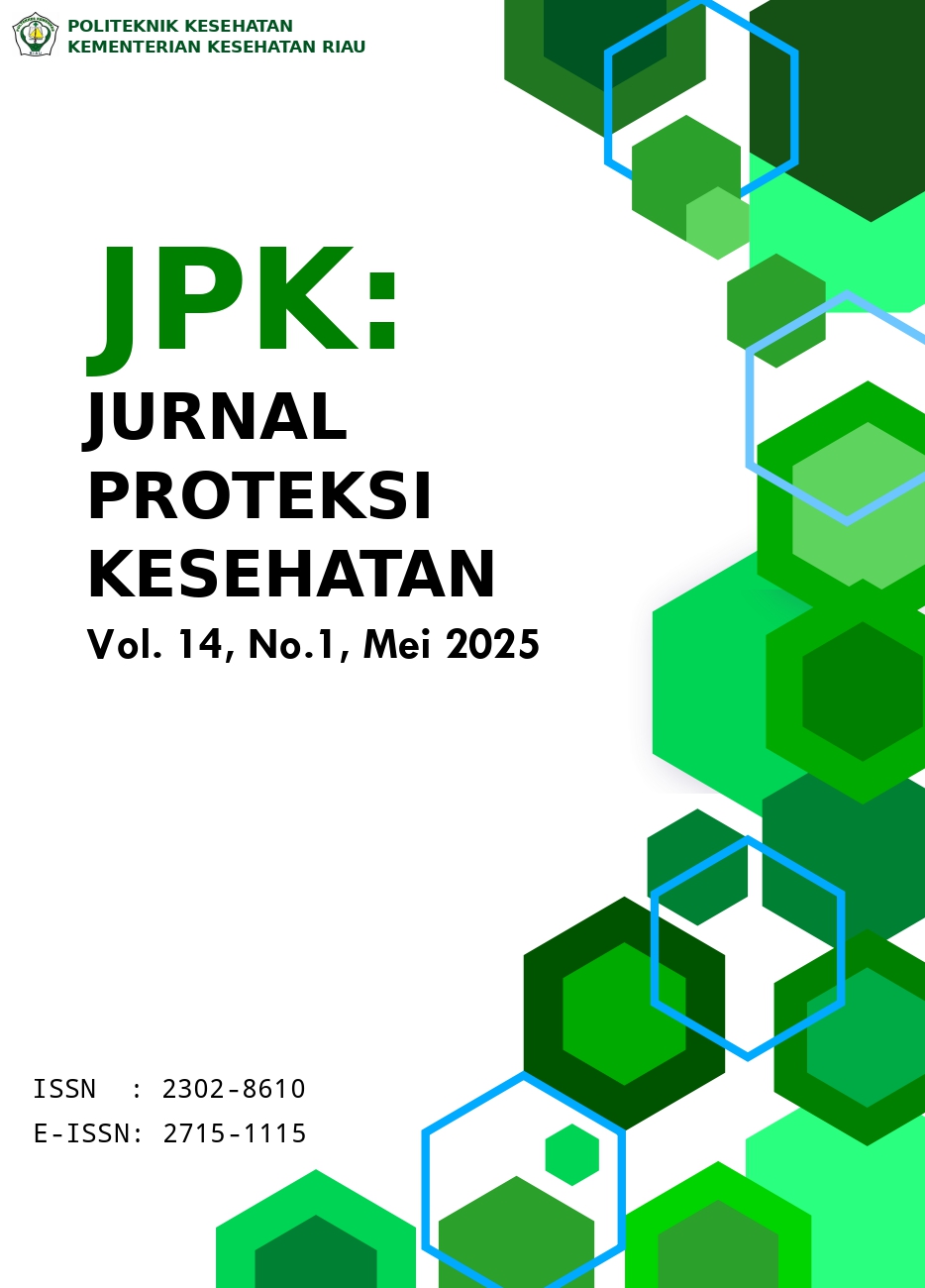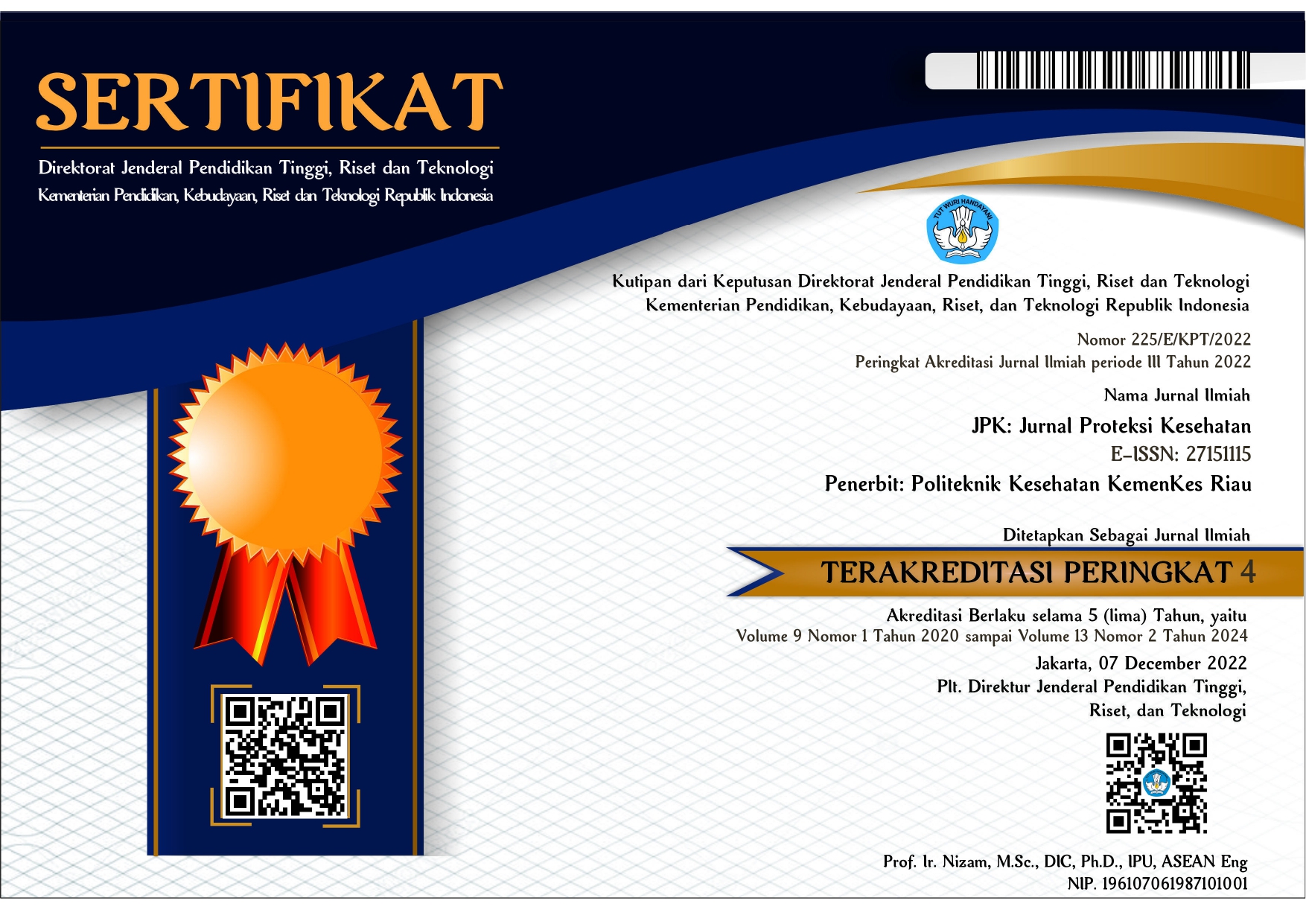Antibacterial Properties of Turmeric Oil Nanoemulsion
Abstract
Turmeric oil is an essential oil extracted from Curcuma domestica rhizome, containing active compounds like turmerone, atlantone, and zingiberone, with various pharmacological activities. This study aimed to evaluate the antibacterial activity of turmeric oil nanoemulsion formulations (F1, F2, F3) against Staphylococcus aureus and Escherichia coli. The nanoemulsions were characterized for organoleptic properties, pH, viscosity, stability, homogeneity, droplet size, and zeta potential. All formulas appeared as thick, yellow, aromatic liquids with good homogeneity, pH of 6.8–7.0, and showed no separation upon centrifugation. Droplet sizes were 23.2 nm (F1), 203.8 nm (F2), and 298.7 nm (F3), with zeta potentials of –18.5 mV, –13.4 mV, and –8.5 mV, respectively. Antibacterial tests using the diffusion method showed moderate activity with inhibition zones ranging from 5.0–9.8 mm. These findings indicate that turmeric oil nanoemulsions are physically stable and exhibit moderate antibacterial activity.
References
[2] Sasidharan A, Kuttithodi AM, Famurewa AC, Pathrose B. “Chemical Composition and Biological Activities of the Leaf Essential Oils of Curcuma longa, Curcuma aromatica and Curcuma angustifolia”, Antibiotics (Basel), vol. 3, no. 11, pp1–14, 2022.
[3] Mara G, Gonçalves S, Barros PP., “The essential oil of Curcuma longa rhizomes as an antimicrobial and its composition by Gas Chromatography/Mass Spectrometry”, Rev. Ciênc. Méd, vol. 28, no.1, pp. 1-10, 2019.
[4] Orellana-Paucar AM, Machado-Orellana MG., “Pharmacological Profile, Bioactivities, and Safety of Turmeric Oil”, Molecules, vol. 27, pp. 1-16, 2022, https://doi.org/10.3390/molecules27165055.
[5] Hans V, Grover H, Deswal H, Agarwal P., “Antimicrobial Efficacy of Various Essential Oils at Varying Concentrations against Periopathogen Porphyromonas gingivalis”, J Clin Diagn Res, 2016, https://doi.org/10.7860/JCDR/2016/18956.8435.
[6] Lee K-H, Kim BS, Keum K-S, Yu H-H, Kim Y-H, Chang B-S, Ra J-Y, Moon H-D, Seo B-R, Choi N-Y, You Y-O., “Essential Oil of Curcuma longa Inhibits Streptococcus mutans Biofilm Formation”, J Food Sci, 2011, https://doi.org/10.1111/j.1750-3841.2011.02427.x.
[7] Teles A, Rosa T, Nascimento A, Abreu-Silva A, Calabrese K, Almeida-Souza F., “Cinnamomum zeylanicum, Origanum vulgare, and Curcuma longa Essential Oils: Chemical Composition, Antimicrobial and Antileishmanial Activity”. Evidence-Based Complementary and Alternative Medicine, 2019, https://doi.org/10.1155/2019/2421695.
[8] Alvarez N, Angulo A, Martínez O., “In vitro antibacterial activity of Curcuma longa (Zingiberaceae) against nosocomial bacteria in Montería”, Colombia. Rev Biol Trop, vol. 64, 2016, https://doi.org/10.15517/rbt.v64i3.20848.
[9] Donsì F, Annunziata M, Sessa M, Ferrari G., “Nanoencapsulation of essential oils to enhance their antimicrobial activity in foods”, LWT - Food Science and Technology, vol. 44, pp. 1908–1914, 2010, https://doi.org/10.1016/j.lwt.2011.03.003.
[10] Rai M, Ingle A., “Role of nanotechnology in agriculture with special reference to management of insect pests”, Appl Microbiol Biotechnol, vol. 94, 2012. https://doi.org/10.1007/s00253-012-3969-4.
[11] Donsì F, Ferrari G., “Essential oil nanoemulsions as antimicrobial agents in food”. J Biotechnol, vol. 233, 2016. https://doi.org/10.1016/j.jbiotec.2016.07.005.
[12] Pandya Mrsc S., “Nanoemulsion And Their Antimicrobial Activity”, Pharmaceuticals (Basel), vol. 15, 2022, https://doi.org/10.13140/RG.2.1.2274.6961.
[13] Hendrika Y, Aulia Z, Mardhiyani D., “Formulation and Characterization of Nanoemulsion Turmeric oil”. JPK : Jurnal Proteksi Kesehatan, vol. 12, 2023, https://doi.org/10.36929/jpk.v12i2.733.
[14] Sondari D, Tursiloadi S., “The effect of surfactan on formulation and stability of nanoemulsion using extract of Centella Asiatica and Zingiber Officinale”, AIP Conf Proc, vol. 2049, p. 30014, 2018, https://doi.org/10.1063/1.5082515.
[15] Yuan Y, Gao Y, Zhao J, Mao L., “Characterization and stability evaluation of β-carotene nanoemulsions prepared by high pressure homogenization under various emulsifying conditions”, Food Research International vol. 41, 2008, https://doi.org/https://doi.org/10.1016/j.foodres.2007.09.006.
[16] Sondari D, Tursiloadi S., “The effect of surfactan on formulation and stability of nanoemulsion using extract of Centella Asiatica and Zingiber Officinale”, AIP Conf Proc, vol. 2049, p. 30014, 2018, https://doi.org/10.1063/1.5082515.
[17] Orellana-Paucar AM., “Turmeric Essential Oil Constituents as Potential Drug Candidates: A Comprehensive Overview of Their Individual Bioactivities”, Molecules, vol. 29, p. 4210, 2024, https://doi.org/10.3390/molecules29174210.
[18] Albaqami J, Hamdi H, Narayanankutty A, N U V, Sasidharan A, Kuttithodi A, Famurewa A, Pathrose B., “Chemical Composition and Biological Activities of the Leaf Essential Oils of Curcuma longa, Curcuma aromatica and Curcuma angustifolia”. Antibiotics, vol. 11, p. 1547, 2022, https://doi.org/10.3390/antibiotics11111547.
[19] Gonçalves G, Barros P, Silva GH da, Fedes G., “The essential oil of Curcuma longa rhizomes as an antimicrobial and its composition by Gas Chromatography/Mass Spectrometry”, Revista de Ciências Médicas, vol. 28, 2019, https://doi.org/10.24220/2318-0897v28n1a4389.
[20] Kongpol, K., Sermkaew, N., Makkliang, F., Khongphan, S., Chuaboon, L., Sakdamas, A., Sakamoto, S., Putalun, W., & Yusakul, G., “Extraction of curcuminoids and ar-turmerone from turmeric (Curcuma longa L.) using hydrophobic deep eutectic solvents (HDESs) and application as HDES-based microemulsions”, Food Chemistry, vol. 396, p. 133728, 2022, https://doi.org/https://doi.org/10.1016/j.foodchem.2022.133728












